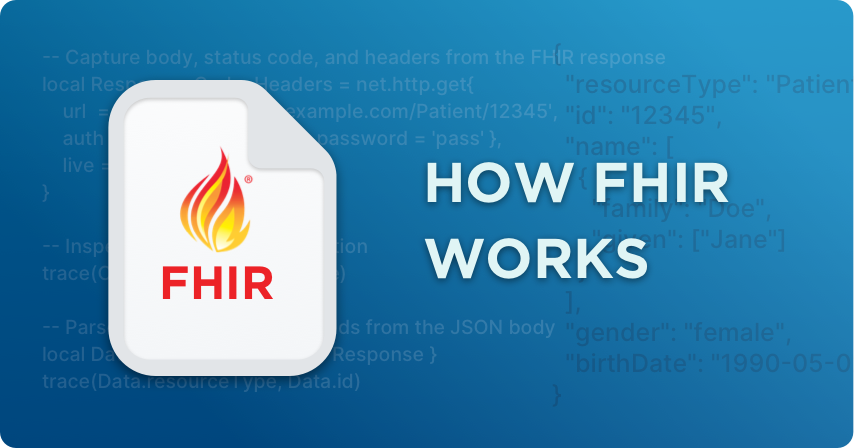
How FHIR Works
FHIR, or Fast Healthcare Interoperability Resources, works by defining how healthcare information is structured, represented, and related across systems. Instead of relying on monolithic documents or custom message formats, FHIR uses standardized data building blocks called 'resources' that can be combined, extended, and exchanged consistently.
Understanding how FHIR works means understanding how these resources fit together to describe the healthcare ecosystem, from patients and encounters to lab results, medications, and beyond.
The Design Principles Behind FHIR
FHIR is built on a few simple but powerful ideas that make interoperability practical in the real world:
- Modularity: All healthcare data is represented as small, reusable pieces called resources.
- Standardization: Every resource follows the same structure and naming conventions.
- Linkability: Resources reference one another to create relationships between people, events, and observations.
- Extensibility: The standard allows customization through profiles and extensions.
- Web Alignment: FHIR uses web-native formats (JSON, XML) and can be accessed through RESTful APIs.
This combination makes FHIR both rigorous and flexible, adaptable to many workflows while maintaining a consistent model across systems.
The Building Blocks: FHIR Resources
At the center of FHIR are resources, which are small, self-contained data structures representing a single concept in healthcare. Each resource contains standard elements like an ID, metadata, and fields specific to its domain.
Examples include:
- Patient: demographic and identifying details
- Observation: lab results or vital signs
- Encounter: visits, admissions, or telehealth events
- Practitioner: information about providers
- Organization: hospitals, clinics, or payers
Every resource follows the same pattern, making it predictable and interoperable. This uniformity allows systems to store, query, and share data even when developed by different vendors.
Relationships Between Resources
FHIR's design mirrors how healthcare works in practice: everything is connected.
Resources reference one another to build a web of relationships:
- A Patient is linked to multiple Encounter records.
- Each Encounter may contain Observation and Condition resources.
- A Practitioner resource connects to the provider responsible for care.
This linked structure lets systems exchange only the data that is needed while preserving context. For example, an application can retrieve all Observations for a patient simply by following references, instead of parsing large composite documents.
Bundles and Data Exchange Patterns
FHIR uses Bundles to package one or more resources together for specific purposes. Bundles describe how information moves between systems, whether as part of a transaction, message, or search result.
Common bundle types include:
- Collection Bundle: a simple list of resources (for example, all Observations for a patient)
- Transaction Bundle: multiple resources sent together as a single operation
- Message Bundle: event-based exchanges such as lab result notifications
- Document Bundle: structured clinical summaries or reports
Bundles give FHIR the flexibility to support both real-time API exchanges and document-style workflows, bridging traditional and modern interoperability methods.
Profiles, Extensions, and Validation
While FHIR defines a universal data model, it also recognizes that healthcare organizations often have local variations. To support this, FHIR provides mechanisms to extend or constrain base definitions.
- Profiles define custom rules for how a resource should look in a specific context (for example, requiring certain fields or limiting data types).
- Extensions allow new elements to be added without breaking compatibility.
This approach ensures consistency while allowing organizations to adapt FHIR to their regional, regulatory, or workflow needs.
Learn more: FHIR Profiles and Extensions
FHIR's Role in Modern Interoperability
FHIR works because it provides a shared framework that every healthcare system can understand. By defining consistent data structures (Resources) and predictable relationships between them, it ensures that information can move safely and accurately between applications, regardless of platform or vendor.
FHIR does not replace older standards like HL7 v2 or CDA; it complements them by offering a simpler, API-friendly way to exchange the same clinical concepts.
How Iguana Helps Implement FHIR
As organizations adopt FHIR, many must integrate it with existing systems, manage hybrid data formats, and maintain compliance with local profiles. Iguana acts as the bridge between these worlds, allowing healthcare teams to:
- Transform HL7 v2 messages into FHIR resources
- Validate FHIR data against profiles and schemas
- Route and log FHIR messages across APIs and internal systems
- Combine RESTful FHIR workflows with legacy interfaces
Iguana makes it possible to adopt FHIR incrementally while maintaining stability and compatibility with existing workflows.
Next: Exploring FHIR Resources
Now that you understand how FHIR is structured and how its components work together, the next step is to explore the resources themselves, the building blocks of every FHIR exchange.
Continue reading: FHIR Resources Overview →